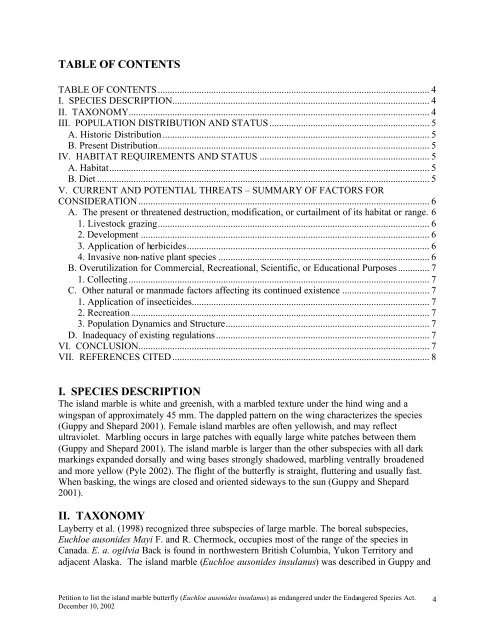island marble - The Xerces Society
island marble - The Xerces Society
island marble - The Xerces Society
Create successful ePaper yourself
Turn your PDF publications into a flip-book with our unique Google optimized e-Paper software.
TABLE OF CONTENTS<br />
TABLE OF CONTENTS................................................................................................................ 4<br />
I. SPECIES DESCRIPTION.......................................................................................................... 4<br />
II. TAXONOMY............................................................................................................................ 4<br />
III. POPULATION DISTRIBUTION AND STATUS.................................................................. 5<br />
A. Historic Distribution .............................................................................................................. 5<br />
B. Present Distribution................................................................................................................ 5<br />
IV. HABITAT REQUIREMENTS AND STATUS ...................................................................... 5<br />
A. Habitat.................................................................................................................................... 5<br />
B. Diet ......................................................................................................................................... 5<br />
V. CURRENT AND POTENTIAL THREATS – SUMMARY OF FACTORS FOR<br />
CONSIDERATION ........................................................................................................................ 6<br />
A. <strong>The</strong> present or threatened destruction, modification, or curtailment of its habitat or range. 6<br />
1. Livestock grazing................................................................................................................ 6<br />
2. Development ....................................................................................................................... 6<br />
3. Application of herbicides.................................................................................................... 6<br />
4. Invasive non-native plant species ....................................................................................... 6<br />
B. Overutilization for Commercial, Recreational, Scientific, or Educational Purposes............. 7<br />
1. Collecting............................................................................................................................ 7<br />
C. Other natural or manmade factors affecting its continued existence .................................... 7<br />
1. Application of insecticides.................................................................................................. 7<br />
2. Recreation ........................................................................................................................... 7<br />
3. Population Dynamics and Structure.................................................................................... 7<br />
D. Inadequacy of existing regulations........................................................................................ 7<br />
VI. CONCLUSION........................................................................................................................ 7<br />
VII. REFERENCES CITED.......................................................................................................... 8<br />
I. SPECIES DESCRIPTION<br />
<strong>The</strong> <strong>island</strong> <strong>marble</strong> is white and greenish, with a <strong>marble</strong>d texture under the hind wing and a<br />
wingspan of approximately 45 mm. <strong>The</strong> dappled pattern on the wing characterizes the species<br />
(Guppy and Shepard 2001). Female <strong>island</strong> <strong>marble</strong>s are often yellowish, and may reflect<br />
ultraviolet. Marbling occurs in large patches with equally large white patches between them<br />
(Guppy and Shepard 2001). <strong>The</strong> <strong>island</strong> <strong>marble</strong> is larger than the other subspecies with all dark<br />
markings expanded dorsally and wing bases strongly shadowed, marbling ventrally broadened<br />
and more yellow (Pyle 2002). <strong>The</strong> flight of the butterfly is straight, fluttering and usually fast.<br />
When basking, the wings are closed and oriented sideways to the sun (Guppy and Shepard<br />
2001).<br />
II. TAXONOMY<br />
Layberry et al. (1998) recognized three subspecies of large <strong>marble</strong>. <strong>The</strong> boreal subspecies,<br />
Euchloe ausonides Mayi F. and R. Chermock, occupies most of the range of the species in<br />
Canada. E. a. ogilvia Back is found in northwestern British Columbia, Yukon Territory and<br />
adjacent Alaska. <strong>The</strong> <strong>island</strong> <strong>marble</strong> (Euchloe ausonides insulanus) was described in Guppy and<br />
Petition to list the <strong>island</strong> <strong>marble</strong> butterfly (Euchloe ausonides insulanus) as endangered under the Endangered Species Act.<br />
December 10, 2002<br />
4
















